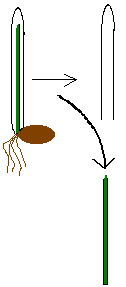Coleoptile

Coleoptile is the pointed protective sheath covering the emerging shoot in monocotyledons such as grasses. Coleoptiles have two vascular bundles, one on either side. Unlike the flag leaves rolled up within, the pre-emergent coleoptile does not accumulate significant protochlorophyll or carotenoids, and so it is generally very pale. Some preemergent coleoptiles do, however, accumulate purple anthocyanin pigments.
Coleoptiles consist of very similar cells that are all specialised to fast stretch growth. They do not divide, but increase in size as they accumulate more water. Coleoptiles also have water vessels (frequently two) along the axis to provide a water supply.
When a coleoptile reaches the surface, it stops growing and the flag leaves penetrate its top, continuing to grow along. The wheat coleoptile is most developed in the third day of the germination (if in the darkness).
Tropisms
Early experiments on phototropism using coleoptiles suggested that plants grow towards light because plant cells on the darker side elongate more than those on the lighter side. In 1880 Charles Darwin and his son, Francis found that coleoptiles only bend towards the light when their tips are exposed.[1] Therefore, the tips must contain the photoreceptor cells although the bending takes place lower down on the shoot. A chemical messenger or hormone called auxin moves down the dark side of the shoot and stimulates growth on that side. The natural plant hormone responsible for phototropism is now known to be indoleacetic acid (IAA).
The Cholodny-Went model is named after Frits Warmolt Went of the California Institute of Technology and the Russian scientist N. Cholodny, who reached the same conclusion independently in 1937. It describes the phototropic and gravitropic properties of emerging shoots of monocotyledons. The model proposes that auxin, a plant growth hormone, is synthesized in the coleoptile tip, which senses light or gravity and will send the auxin down the appropriate side of the shoot. This causes asymmetric growth of one side of the plant. As a result, the plant shoot will begin to bend toward a light source or toward the surface.[2]
Coleoptiles also exhibit strong geotropic reaction, always growing upward and correcting direction after reorientation. Geotropic reaction is regulated by light (more exactly by phytochrome action).
References
- ↑ Darwin, C. R. (1880). The Power of Movement in Plants. London: Murray.
- ↑ Rashotte; et al. (February 2000). "Basipetal Auxin Transport Is Required for Gravitropism in Roots of Arabidopsis". Plant Physiology. 122 (2): 481–490. doi:10.1104/pp.122.2.481.
External links
 Media related to Coleoptiles at Wikimedia Commons
Media related to Coleoptiles at Wikimedia Commons